Analysis of National Technological Innovation System: Essay Report
VerifiedAdded on 2019/12/28
|13
|3825
|107
Essay
AI Summary
This essay provides a comprehensive analysis of the national technological innovation system (NTIS). It begins by defining the NTIS as a dynamic network involving actors, institutions, networks, and technological factors, highlighting the interconnectedness of knowledge institutes, industries, market actors, government bodies, and educational organizations. The essay then explores the structure of the NTIS, emphasizing technology, market dynamics, policy, and intermediary roles. It defines the concept of the NTIS, focusing on knowledge flow and technological change within an industry and its infrastructure. The strengths of the NTIS are discussed, including its role in innovation, technical assistance, knowledge flow, and economic growth. Conversely, it also identifies weaknesses, such as documentation issues, potential implementation challenges, and the risks associated with large-scale system implementation. The essay concludes by summarizing the key characteristics, strengths, and weaknesses of the NTIS, offering a balanced view of its contributions and limitations.

Student identification number
Title of the Programme
Year and month of your cohort,
Title of the course
Assignment deadline date
Title of the Programme
Year and month of your cohort,
Title of the course
Assignment deadline date
Paraphrase This Document
Need a fresh take? Get an instant paraphrase of this document with our AI Paraphraser

Contents
Introduction:...................................................................................................................3
Concept of national system of innovation......................................................................4
Strengths –......................................................................................................................6
Weaknesses –.................................................................................................................7
Conclusion:....................................................................................................................8
References:.....................................................................................................................9
Introduction:...................................................................................................................3
Concept of national system of innovation......................................................................4
Strengths –......................................................................................................................6
Weaknesses –.................................................................................................................7
Conclusion:....................................................................................................................8
References:.....................................................................................................................9
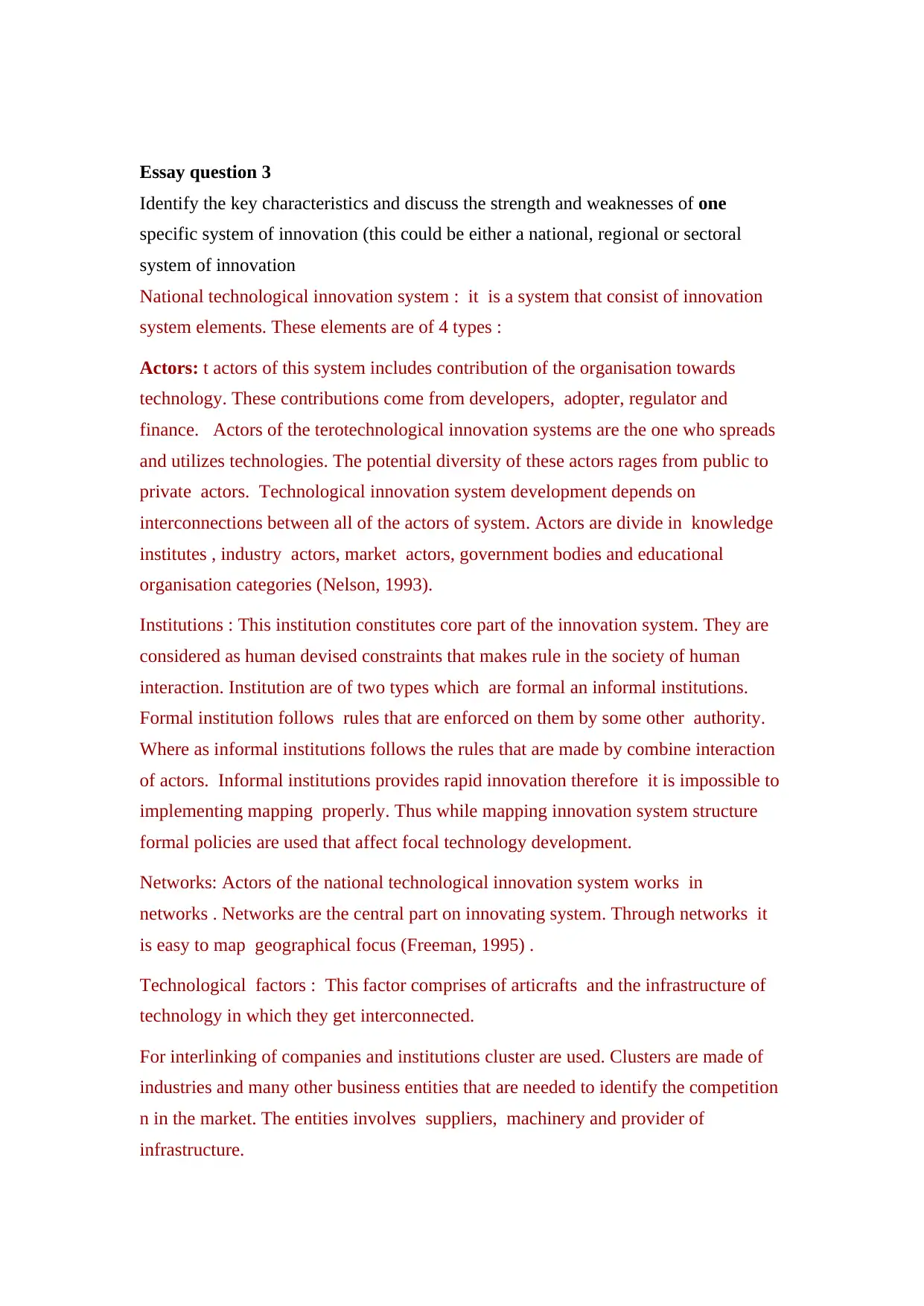
Essay question 3
Identify the key characteristics and discuss the strength and weaknesses of one
specific system of innovation (this could be either a national, regional or sectoral
system of innovation
National technological innovation system : it is a system that consist of innovation
system elements. These elements are of 4 types :
Actors: t actors of this system includes contribution of the organisation towards
technology. These contributions come from developers, adopter, regulator and
finance. Actors of the terotechnological innovation systems are the one who spreads
and utilizes technologies. The potential diversity of these actors rages from public to
private actors. Technological innovation system development depends on
interconnections between all of the actors of system. Actors are divide in knowledge
institutes , industry actors, market actors, government bodies and educational
organisation categories (Nelson, 1993).
Institutions : This institution constitutes core part of the innovation system. They are
considered as human devised constraints that makes rule in the society of human
interaction. Institution are of two types which are formal an informal institutions.
Formal institution follows rules that are enforced on them by some other authority.
Where as informal institutions follows the rules that are made by combine interaction
of actors. Informal institutions provides rapid innovation therefore it is impossible to
implementing mapping properly. Thus while mapping innovation system structure
formal policies are used that affect focal technology development.
Networks: Actors of the national technological innovation system works in
networks . Networks are the central part on innovating system. Through networks it
is easy to map geographical focus (Freeman, 1995) .
Technological factors : This factor comprises of articrafts and the infrastructure of
technology in which they get interconnected.
For interlinking of companies and institutions cluster are used. Clusters are made of
industries and many other business entities that are needed to identify the competition
n in the market. The entities involves suppliers, machinery and provider of
infrastructure.
Identify the key characteristics and discuss the strength and weaknesses of one
specific system of innovation (this could be either a national, regional or sectoral
system of innovation
National technological innovation system : it is a system that consist of innovation
system elements. These elements are of 4 types :
Actors: t actors of this system includes contribution of the organisation towards
technology. These contributions come from developers, adopter, regulator and
finance. Actors of the terotechnological innovation systems are the one who spreads
and utilizes technologies. The potential diversity of these actors rages from public to
private actors. Technological innovation system development depends on
interconnections between all of the actors of system. Actors are divide in knowledge
institutes , industry actors, market actors, government bodies and educational
organisation categories (Nelson, 1993).
Institutions : This institution constitutes core part of the innovation system. They are
considered as human devised constraints that makes rule in the society of human
interaction. Institution are of two types which are formal an informal institutions.
Formal institution follows rules that are enforced on them by some other authority.
Where as informal institutions follows the rules that are made by combine interaction
of actors. Informal institutions provides rapid innovation therefore it is impossible to
implementing mapping properly. Thus while mapping innovation system structure
formal policies are used that affect focal technology development.
Networks: Actors of the national technological innovation system works in
networks . Networks are the central part on innovating system. Through networks it
is easy to map geographical focus (Freeman, 1995) .
Technological factors : This factor comprises of articrafts and the infrastructure of
technology in which they get interconnected.
For interlinking of companies and institutions cluster are used. Clusters are made of
industries and many other business entities that are needed to identify the competition
n in the market. The entities involves suppliers, machinery and provider of
infrastructure.
⊘ This is a preview!⊘
Do you want full access?
Subscribe today to unlock all pages.

Trusted by 1+ million students worldwide
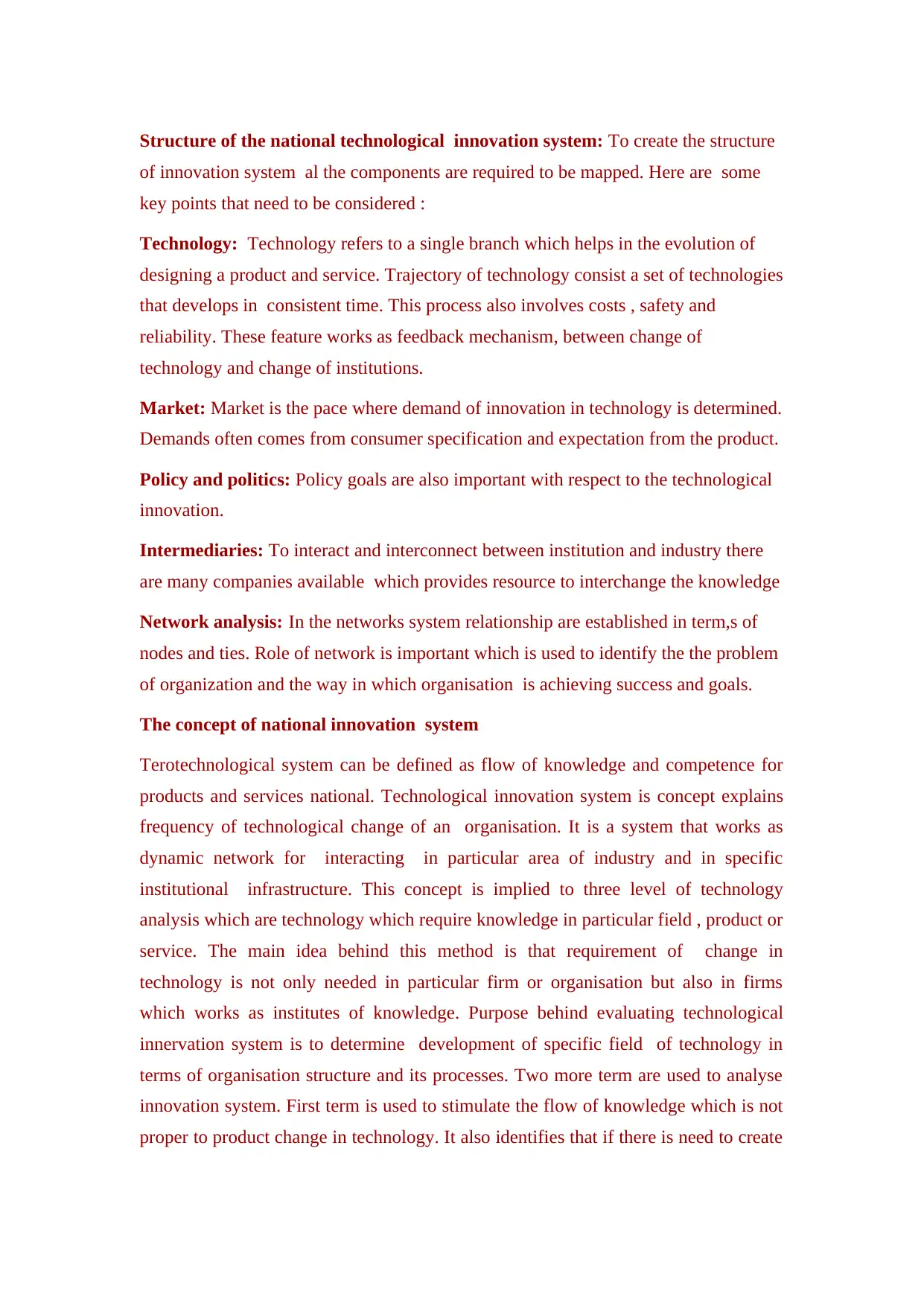
Structure of the national technological innovation system: To create the structure
of innovation system al the components are required to be mapped. Here are some
key points that need to be considered :
Technology: Technology refers to a single branch which helps in the evolution of
designing a product and service. Trajectory of technology consist a set of technologies
that develops in consistent time. This process also involves costs , safety and
reliability. These feature works as feedback mechanism, between change of
technology and change of institutions.
Market: Market is the pace where demand of innovation in technology is determined.
Demands often comes from consumer specification and expectation from the product.
Policy and politics: Policy goals are also important with respect to the technological
innovation.
Intermediaries: To interact and interconnect between institution and industry there
are many companies available which provides resource to interchange the knowledge
Network analysis: In the networks system relationship are established in term,s of
nodes and ties. Role of network is important which is used to identify the the problem
of organization and the way in which organisation is achieving success and goals.
The concept of national innovation system
Terotechnological system can be defined as flow of knowledge and competence for
products and services national. Technological innovation system is concept explains
frequency of technological change of an organisation. It is a system that works as
dynamic network for interacting in particular area of industry and in specific
institutional infrastructure. This concept is implied to three level of technology
analysis which are technology which require knowledge in particular field , product or
service. The main idea behind this method is that requirement of change in
technology is not only needed in particular firm or organisation but also in firms
which works as institutes of knowledge. Purpose behind evaluating technological
innervation system is to determine development of specific field of technology in
terms of organisation structure and its processes. Two more term are used to analyse
innovation system. First term is used to stimulate the flow of knowledge which is not
proper to product change in technology. It also identifies that if there is need to create
of innovation system al the components are required to be mapped. Here are some
key points that need to be considered :
Technology: Technology refers to a single branch which helps in the evolution of
designing a product and service. Trajectory of technology consist a set of technologies
that develops in consistent time. This process also involves costs , safety and
reliability. These feature works as feedback mechanism, between change of
technology and change of institutions.
Market: Market is the pace where demand of innovation in technology is determined.
Demands often comes from consumer specification and expectation from the product.
Policy and politics: Policy goals are also important with respect to the technological
innovation.
Intermediaries: To interact and interconnect between institution and industry there
are many companies available which provides resource to interchange the knowledge
Network analysis: In the networks system relationship are established in term,s of
nodes and ties. Role of network is important which is used to identify the the problem
of organization and the way in which organisation is achieving success and goals.
The concept of national innovation system
Terotechnological system can be defined as flow of knowledge and competence for
products and services national. Technological innovation system is concept explains
frequency of technological change of an organisation. It is a system that works as
dynamic network for interacting in particular area of industry and in specific
institutional infrastructure. This concept is implied to three level of technology
analysis which are technology which require knowledge in particular field , product or
service. The main idea behind this method is that requirement of change in
technology is not only needed in particular firm or organisation but also in firms
which works as institutes of knowledge. Purpose behind evaluating technological
innervation system is to determine development of specific field of technology in
terms of organisation structure and its processes. Two more term are used to analyse
innovation system. First term is used to stimulate the flow of knowledge which is not
proper to product change in technology. It also identifies that if there is need to create
Paraphrase This Document
Need a fresh take? Get an instant paraphrase of this document with our AI Paraphraser
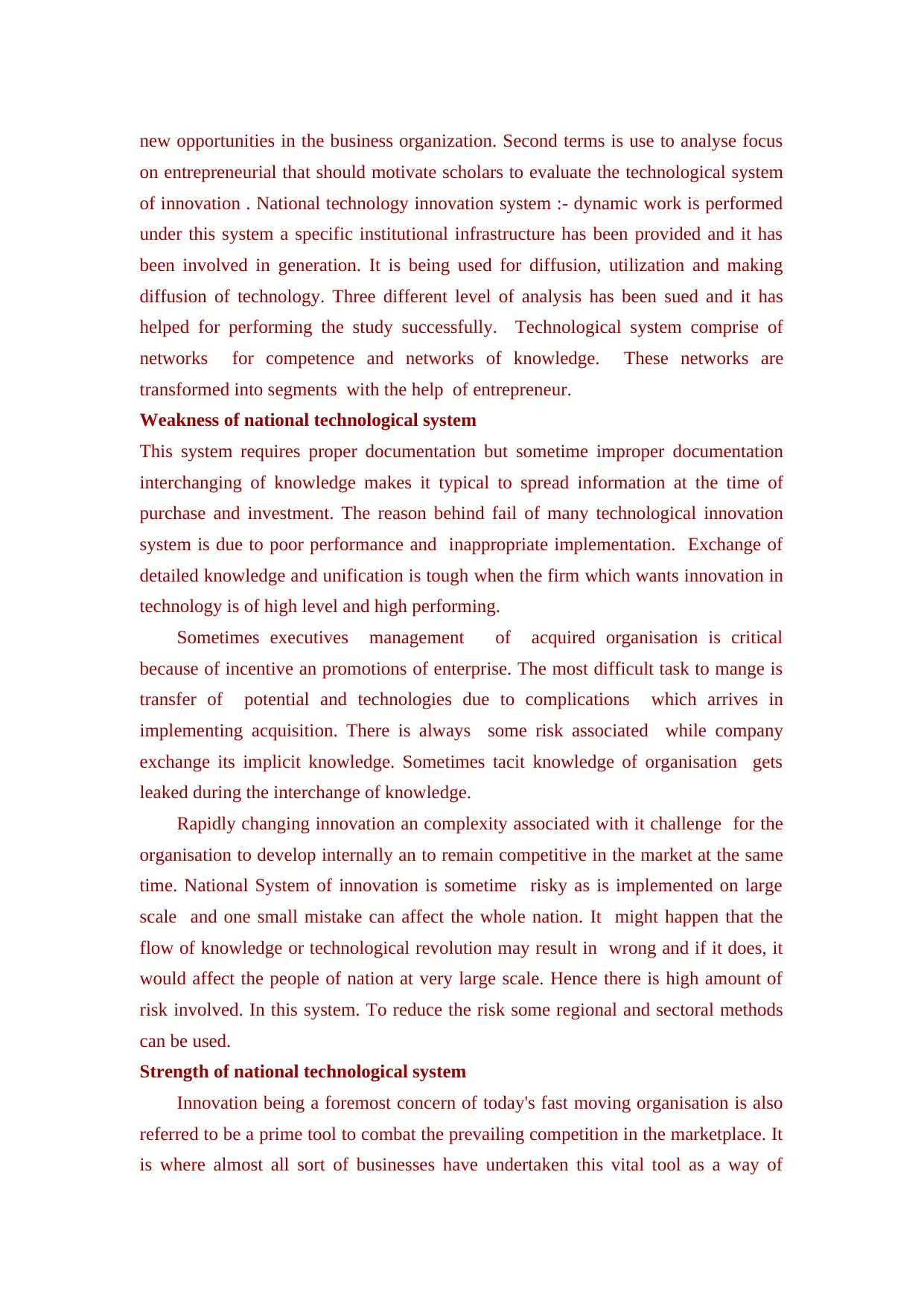
new opportunities in the business organization. Second terms is use to analyse focus
on entrepreneurial that should motivate scholars to evaluate the technological system
of innovation . National technology innovation system :- dynamic work is performed
under this system a specific institutional infrastructure has been provided and it has
been involved in generation. It is being used for diffusion, utilization and making
diffusion of technology. Three different level of analysis has been sued and it has
helped for performing the study successfully. Technological system comprise of
networks for competence and networks of knowledge. These networks are
transformed into segments with the help of entrepreneur.
Weakness of national technological system
This system requires proper documentation but sometime improper documentation
interchanging of knowledge makes it typical to spread information at the time of
purchase and investment. The reason behind fail of many technological innovation
system is due to poor performance and inappropriate implementation. Exchange of
detailed knowledge and unification is tough when the firm which wants innovation in
technology is of high level and high performing.
Sometimes executives management of acquired organisation is critical
because of incentive an promotions of enterprise. The most difficult task to mange is
transfer of potential and technologies due to complications which arrives in
implementing acquisition. There is always some risk associated while company
exchange its implicit knowledge. Sometimes tacit knowledge of organisation gets
leaked during the interchange of knowledge.
Rapidly changing innovation an complexity associated with it challenge for the
organisation to develop internally an to remain competitive in the market at the same
time. National System of innovation is sometime risky as is implemented on large
scale and one small mistake can affect the whole nation. It might happen that the
flow of knowledge or technological revolution may result in wrong and if it does, it
would affect the people of nation at very large scale. Hence there is high amount of
risk involved. In this system. To reduce the risk some regional and sectoral methods
can be used.
Strength of national technological system
Innovation being a foremost concern of today's fast moving organisation is also
referred to be a prime tool to combat the prevailing competition in the marketplace. It
is where almost all sort of businesses have undertaken this vital tool as a way of
on entrepreneurial that should motivate scholars to evaluate the technological system
of innovation . National technology innovation system :- dynamic work is performed
under this system a specific institutional infrastructure has been provided and it has
been involved in generation. It is being used for diffusion, utilization and making
diffusion of technology. Three different level of analysis has been sued and it has
helped for performing the study successfully. Technological system comprise of
networks for competence and networks of knowledge. These networks are
transformed into segments with the help of entrepreneur.
Weakness of national technological system
This system requires proper documentation but sometime improper documentation
interchanging of knowledge makes it typical to spread information at the time of
purchase and investment. The reason behind fail of many technological innovation
system is due to poor performance and inappropriate implementation. Exchange of
detailed knowledge and unification is tough when the firm which wants innovation in
technology is of high level and high performing.
Sometimes executives management of acquired organisation is critical
because of incentive an promotions of enterprise. The most difficult task to mange is
transfer of potential and technologies due to complications which arrives in
implementing acquisition. There is always some risk associated while company
exchange its implicit knowledge. Sometimes tacit knowledge of organisation gets
leaked during the interchange of knowledge.
Rapidly changing innovation an complexity associated with it challenge for the
organisation to develop internally an to remain competitive in the market at the same
time. National System of innovation is sometime risky as is implemented on large
scale and one small mistake can affect the whole nation. It might happen that the
flow of knowledge or technological revolution may result in wrong and if it does, it
would affect the people of nation at very large scale. Hence there is high amount of
risk involved. In this system. To reduce the risk some regional and sectoral methods
can be used.
Strength of national technological system
Innovation being a foremost concern of today's fast moving organisation is also
referred to be a prime tool to combat the prevailing competition in the marketplace. It
is where almost all sort of businesses have undertaken this vital tool as a way of
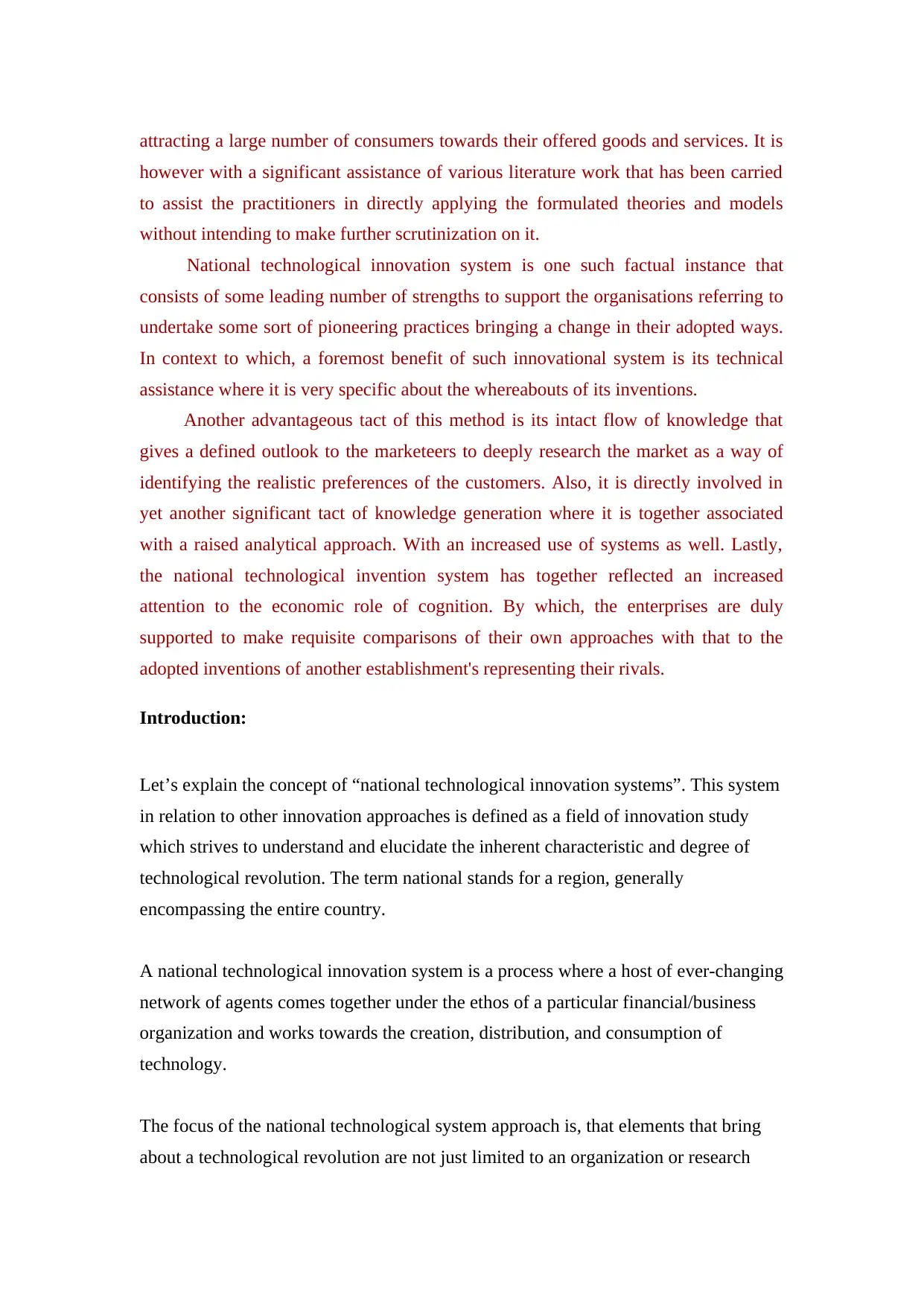
attracting a large number of consumers towards their offered goods and services. It is
however with a significant assistance of various literature work that has been carried
to assist the practitioners in directly applying the formulated theories and models
without intending to make further scrutinization on it.
National technological innovation system is one such factual instance that
consists of some leading number of strengths to support the organisations referring to
undertake some sort of pioneering practices bringing a change in their adopted ways.
In context to which, a foremost benefit of such innovational system is its technical
assistance where it is very specific about the whereabouts of its inventions.
Another advantageous tact of this method is its intact flow of knowledge that
gives a defined outlook to the marketeers to deeply research the market as a way of
identifying the realistic preferences of the customers. Also, it is directly involved in
yet another significant tact of knowledge generation where it is together associated
with a raised analytical approach. With an increased use of systems as well. Lastly,
the national technological invention system has together reflected an increased
attention to the economic role of cognition. By which, the enterprises are duly
supported to make requisite comparisons of their own approaches with that to the
adopted inventions of another establishment's representing their rivals.
Introduction:
Let’s explain the concept of “national technological innovation systems”. This system
in relation to other innovation approaches is defined as a field of innovation study
which strives to understand and elucidate the inherent characteristic and degree of
technological revolution. The term national stands for a region, generally
encompassing the entire country.
A national technological innovation system is a process where a host of ever-changing
network of agents comes together under the ethos of a particular financial/business
organization and works towards the creation, distribution, and consumption of
technology.
The focus of the national technological system approach is, that elements that bring
about a technological revolution are not just limited to an organization or research
however with a significant assistance of various literature work that has been carried
to assist the practitioners in directly applying the formulated theories and models
without intending to make further scrutinization on it.
National technological innovation system is one such factual instance that
consists of some leading number of strengths to support the organisations referring to
undertake some sort of pioneering practices bringing a change in their adopted ways.
In context to which, a foremost benefit of such innovational system is its technical
assistance where it is very specific about the whereabouts of its inventions.
Another advantageous tact of this method is its intact flow of knowledge that
gives a defined outlook to the marketeers to deeply research the market as a way of
identifying the realistic preferences of the customers. Also, it is directly involved in
yet another significant tact of knowledge generation where it is together associated
with a raised analytical approach. With an increased use of systems as well. Lastly,
the national technological invention system has together reflected an increased
attention to the economic role of cognition. By which, the enterprises are duly
supported to make requisite comparisons of their own approaches with that to the
adopted inventions of another establishment's representing their rivals.
Introduction:
Let’s explain the concept of “national technological innovation systems”. This system
in relation to other innovation approaches is defined as a field of innovation study
which strives to understand and elucidate the inherent characteristic and degree of
technological revolution. The term national stands for a region, generally
encompassing the entire country.
A national technological innovation system is a process where a host of ever-changing
network of agents comes together under the ethos of a particular financial/business
organization and works towards the creation, distribution, and consumption of
technology.
The focus of the national technological system approach is, that elements that bring
about a technological revolution are not just limited to an organization or research
⊘ This is a preview!⊘
Do you want full access?
Subscribe today to unlock all pages.

Trusted by 1+ million students worldwide
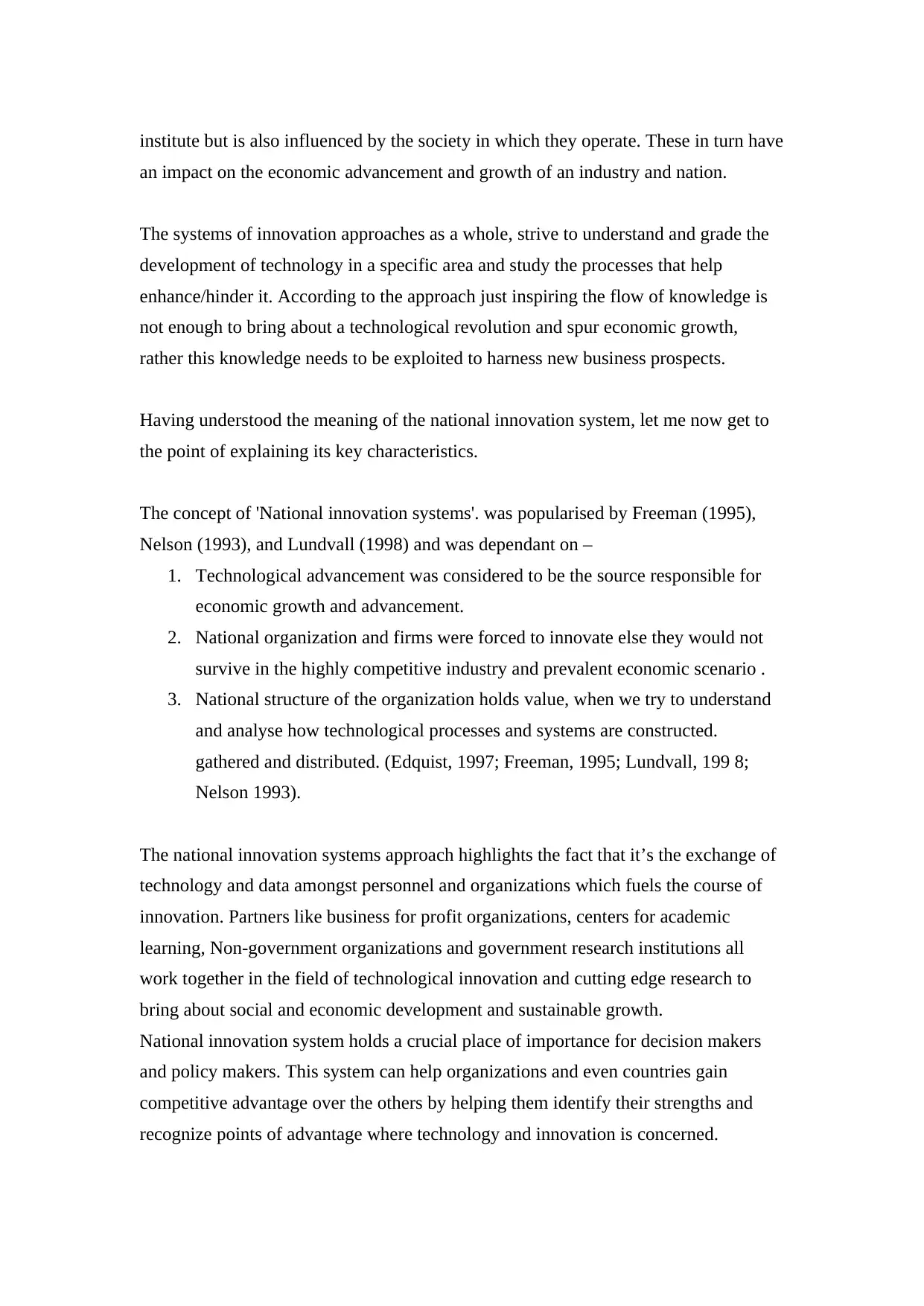
institute but is also influenced by the society in which they operate. These in turn have
an impact on the economic advancement and growth of an industry and nation.
The systems of innovation approaches as a whole, strive to understand and grade the
development of technology in a specific area and study the processes that help
enhance/hinder it. According to the approach just inspiring the flow of knowledge is
not enough to bring about a technological revolution and spur economic growth,
rather this knowledge needs to be exploited to harness new business prospects.
Having understood the meaning of the national innovation system, let me now get to
the point of explaining its key characteristics.
The concept of 'National innovation systems'. was popularised by Freeman (1995),
Nelson (1993), and Lundvall (1998) and was dependant on –
1. Technological advancement was considered to be the source responsible for
economic growth and advancement.
2. National organization and firms were forced to innovate else they would not
survive in the highly competitive industry and prevalent economic scenario .
3. National structure of the organization holds value, when we try to understand
and analyse how technological processes and systems are constructed.
gathered and distributed. (Edquist, 1997; Freeman, 1995; Lundvall, 199 8;
Nelson 1993).
The national innovation systems approach highlights the fact that it’s the exchange of
technology and data amongst personnel and organizations which fuels the course of
innovation. Partners like business for profit organizations, centers for academic
learning, Non-government organizations and government research institutions all
work together in the field of technological innovation and cutting edge research to
bring about social and economic development and sustainable growth.
National innovation system holds a crucial place of importance for decision makers
and policy makers. This system can help organizations and even countries gain
competitive advantage over the others by helping them identify their strengths and
recognize points of advantage where technology and innovation is concerned.
an impact on the economic advancement and growth of an industry and nation.
The systems of innovation approaches as a whole, strive to understand and grade the
development of technology in a specific area and study the processes that help
enhance/hinder it. According to the approach just inspiring the flow of knowledge is
not enough to bring about a technological revolution and spur economic growth,
rather this knowledge needs to be exploited to harness new business prospects.
Having understood the meaning of the national innovation system, let me now get to
the point of explaining its key characteristics.
The concept of 'National innovation systems'. was popularised by Freeman (1995),
Nelson (1993), and Lundvall (1998) and was dependant on –
1. Technological advancement was considered to be the source responsible for
economic growth and advancement.
2. National organization and firms were forced to innovate else they would not
survive in the highly competitive industry and prevalent economic scenario .
3. National structure of the organization holds value, when we try to understand
and analyse how technological processes and systems are constructed.
gathered and distributed. (Edquist, 1997; Freeman, 1995; Lundvall, 199 8;
Nelson 1993).
The national innovation systems approach highlights the fact that it’s the exchange of
technology and data amongst personnel and organizations which fuels the course of
innovation. Partners like business for profit organizations, centers for academic
learning, Non-government organizations and government research institutions all
work together in the field of technological innovation and cutting edge research to
bring about social and economic development and sustainable growth.
National innovation system holds a crucial place of importance for decision makers
and policy makers. This system can help organizations and even countries gain
competitive advantage over the others by helping them identify their strengths and
recognize points of advantage where technology and innovation is concerned.
Paraphrase This Document
Need a fresh take? Get an instant paraphrase of this document with our AI Paraphraser
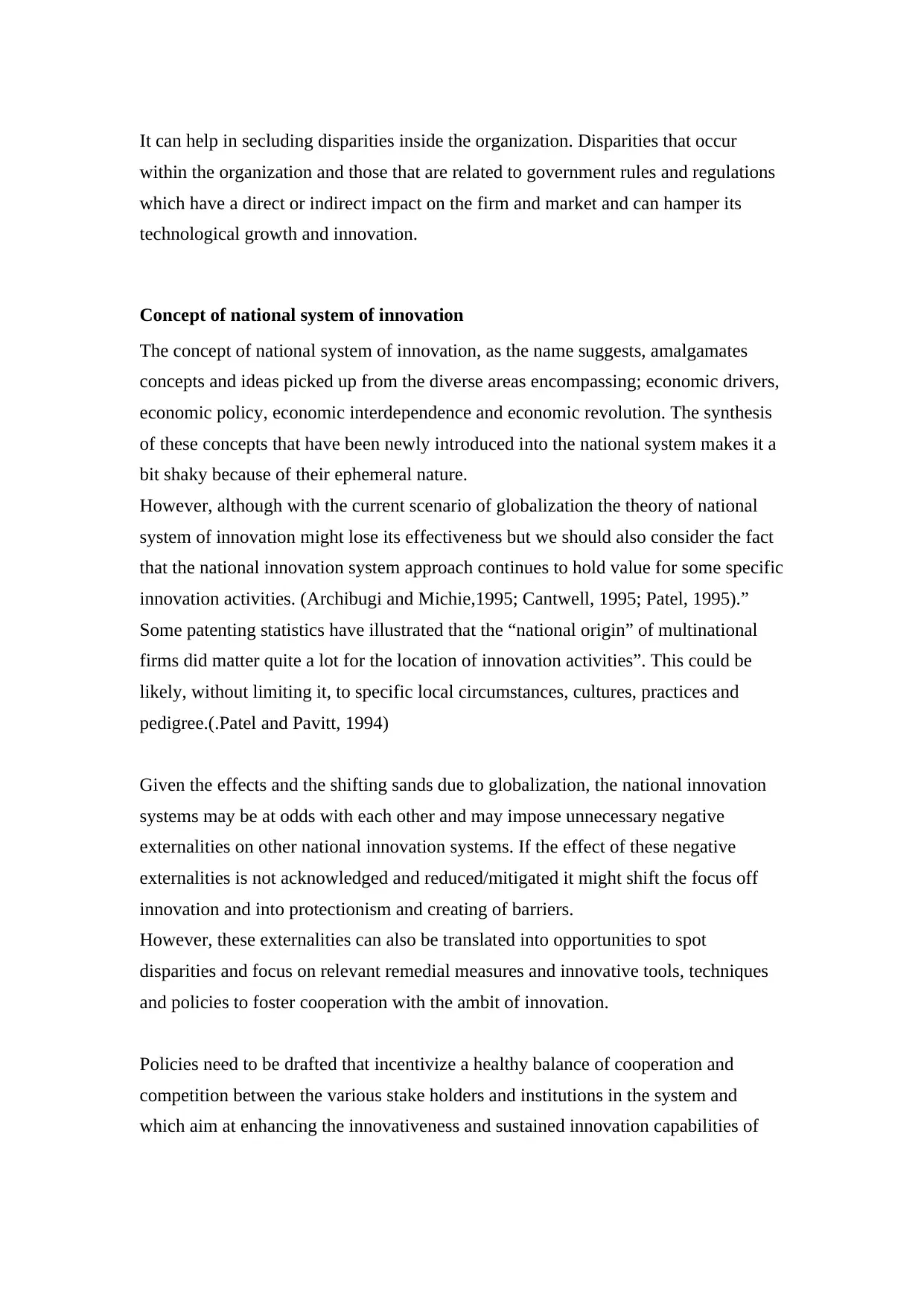
It can help in secluding disparities inside the organization. Disparities that occur
within the organization and those that are related to government rules and regulations
which have a direct or indirect impact on the firm and market and can hamper its
technological growth and innovation.
Concept of national system of innovation
The concept of national system of innovation, as the name suggests, amalgamates
concepts and ideas picked up from the diverse areas encompassing; economic drivers,
economic policy, economic interdependence and economic revolution. The synthesis
of these concepts that have been newly introduced into the national system makes it a
bit shaky because of their ephemeral nature.
However, although with the current scenario of globalization the theory of national
system of innovation might lose its effectiveness but we should also consider the fact
that the national innovation system approach continues to hold value for some specific
innovation activities. (Archibugi and Michie,1995; Cantwell, 1995; Patel, 1995).”
Some patenting statistics have illustrated that the “national origin” of multinational
firms did matter quite a lot for the location of innovation activities”. This could be
likely, without limiting it, to specific local circumstances, cultures, practices and
pedigree.(.Patel and Pavitt, 1994)
Given the effects and the shifting sands due to globalization, the national innovation
systems may be at odds with each other and may impose unnecessary negative
externalities on other national innovation systems. If the effect of these negative
externalities is not acknowledged and reduced/mitigated it might shift the focus off
innovation and into protectionism and creating of barriers.
However, these externalities can also be translated into opportunities to spot
disparities and focus on relevant remedial measures and innovative tools, techniques
and policies to foster cooperation with the ambit of innovation.
Policies need to be drafted that incentivize a healthy balance of cooperation and
competition between the various stake holders and institutions in the system and
which aim at enhancing the innovativeness and sustained innovation capabilities of
within the organization and those that are related to government rules and regulations
which have a direct or indirect impact on the firm and market and can hamper its
technological growth and innovation.
Concept of national system of innovation
The concept of national system of innovation, as the name suggests, amalgamates
concepts and ideas picked up from the diverse areas encompassing; economic drivers,
economic policy, economic interdependence and economic revolution. The synthesis
of these concepts that have been newly introduced into the national system makes it a
bit shaky because of their ephemeral nature.
However, although with the current scenario of globalization the theory of national
system of innovation might lose its effectiveness but we should also consider the fact
that the national innovation system approach continues to hold value for some specific
innovation activities. (Archibugi and Michie,1995; Cantwell, 1995; Patel, 1995).”
Some patenting statistics have illustrated that the “national origin” of multinational
firms did matter quite a lot for the location of innovation activities”. This could be
likely, without limiting it, to specific local circumstances, cultures, practices and
pedigree.(.Patel and Pavitt, 1994)
Given the effects and the shifting sands due to globalization, the national innovation
systems may be at odds with each other and may impose unnecessary negative
externalities on other national innovation systems. If the effect of these negative
externalities is not acknowledged and reduced/mitigated it might shift the focus off
innovation and into protectionism and creating of barriers.
However, these externalities can also be translated into opportunities to spot
disparities and focus on relevant remedial measures and innovative tools, techniques
and policies to foster cooperation with the ambit of innovation.
Policies need to be drafted that incentivize a healthy balance of cooperation and
competition between the various stake holders and institutions in the system and
which aim at enhancing the innovativeness and sustained innovation capabilities of
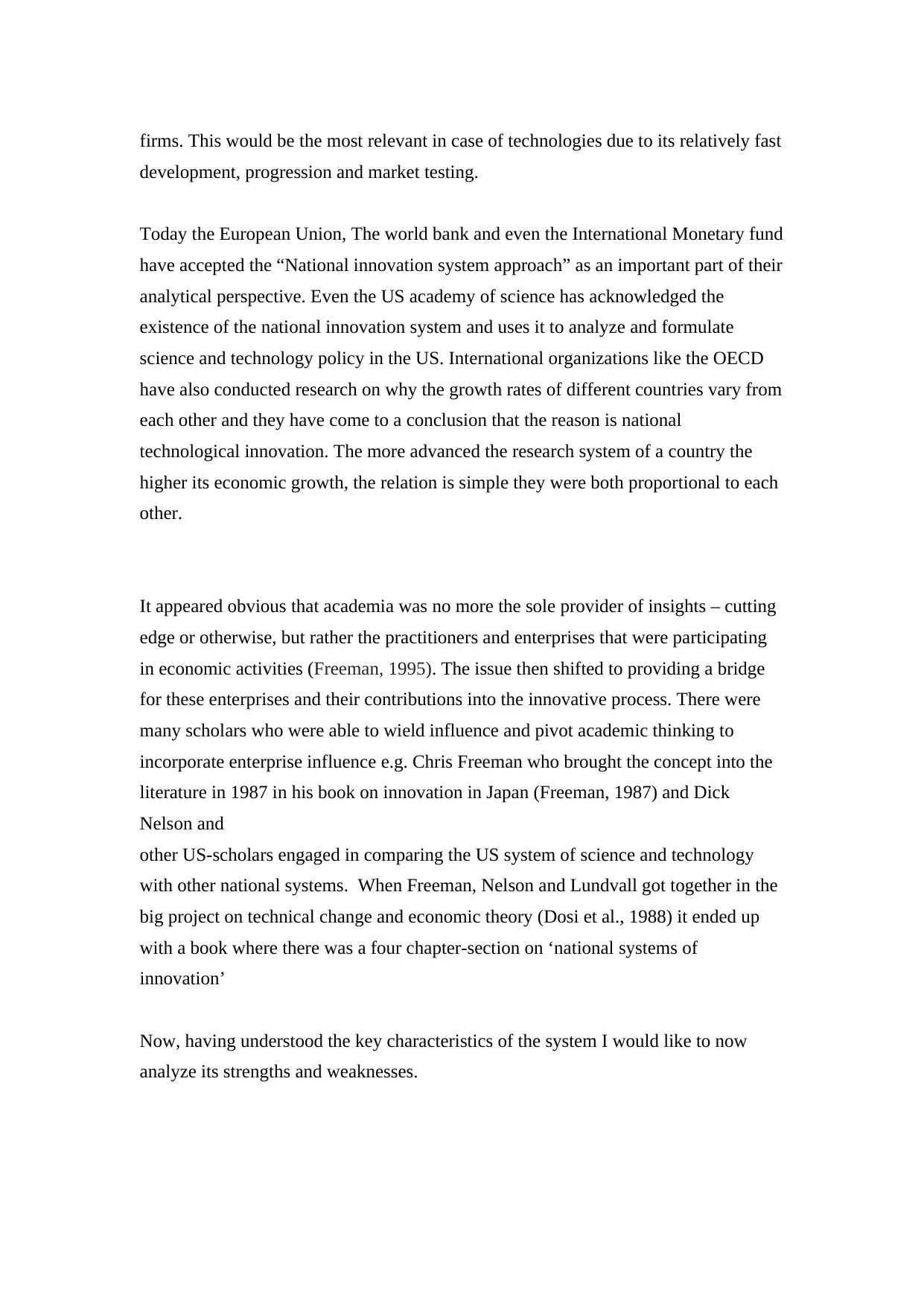
firms. This would be the most relevant in case of technologies due to its relatively fast
development, progression and market testing.
Today the European Union, The world bank and even the International Monetary fund
have accepted the “National innovation system approach” as an important part of their
analytical perspective. Even the US academy of science has acknowledged the
existence of the national innovation system and uses it to analyze and formulate
science and technology policy in the US. International organizations like the OECD
have also conducted research on why the growth rates of different countries vary from
each other and they have come to a conclusion that the reason is national
technological innovation. The more advanced the research system of a country the
higher its economic growth, the relation is simple they were both proportional to each
other.
It appeared obvious that academia was no more the sole provider of insights – cutting
edge or otherwise, but rather the practitioners and enterprises that were participating
in economic activities (Freeman, 1995). The issue then shifted to providing a bridge
for these enterprises and their contributions into the innovative process. There were
many scholars who were able to wield influence and pivot academic thinking to
incorporate enterprise influence e.g. Chris Freeman who brought the concept into the
literature in 1987 in his book on innovation in Japan (Freeman, 1987) and Dick
Nelson and
other US-scholars engaged in comparing the US system of science and technology
with other national systems. When Freeman, Nelson and Lundvall got together in the
big project on technical change and economic theory (Dosi et al., 1988) it ended up
with a book where there was a four chapter-section on ‘national systems of
innovation’
Now, having understood the key characteristics of the system I would like to now
analyze its strengths and weaknesses.
development, progression and market testing.
Today the European Union, The world bank and even the International Monetary fund
have accepted the “National innovation system approach” as an important part of their
analytical perspective. Even the US academy of science has acknowledged the
existence of the national innovation system and uses it to analyze and formulate
science and technology policy in the US. International organizations like the OECD
have also conducted research on why the growth rates of different countries vary from
each other and they have come to a conclusion that the reason is national
technological innovation. The more advanced the research system of a country the
higher its economic growth, the relation is simple they were both proportional to each
other.
It appeared obvious that academia was no more the sole provider of insights – cutting
edge or otherwise, but rather the practitioners and enterprises that were participating
in economic activities (Freeman, 1995). The issue then shifted to providing a bridge
for these enterprises and their contributions into the innovative process. There were
many scholars who were able to wield influence and pivot academic thinking to
incorporate enterprise influence e.g. Chris Freeman who brought the concept into the
literature in 1987 in his book on innovation in Japan (Freeman, 1987) and Dick
Nelson and
other US-scholars engaged in comparing the US system of science and technology
with other national systems. When Freeman, Nelson and Lundvall got together in the
big project on technical change and economic theory (Dosi et al., 1988) it ended up
with a book where there was a four chapter-section on ‘national systems of
innovation’
Now, having understood the key characteristics of the system I would like to now
analyze its strengths and weaknesses.
⊘ This is a preview!⊘
Do you want full access?
Subscribe today to unlock all pages.

Trusted by 1+ million students worldwide
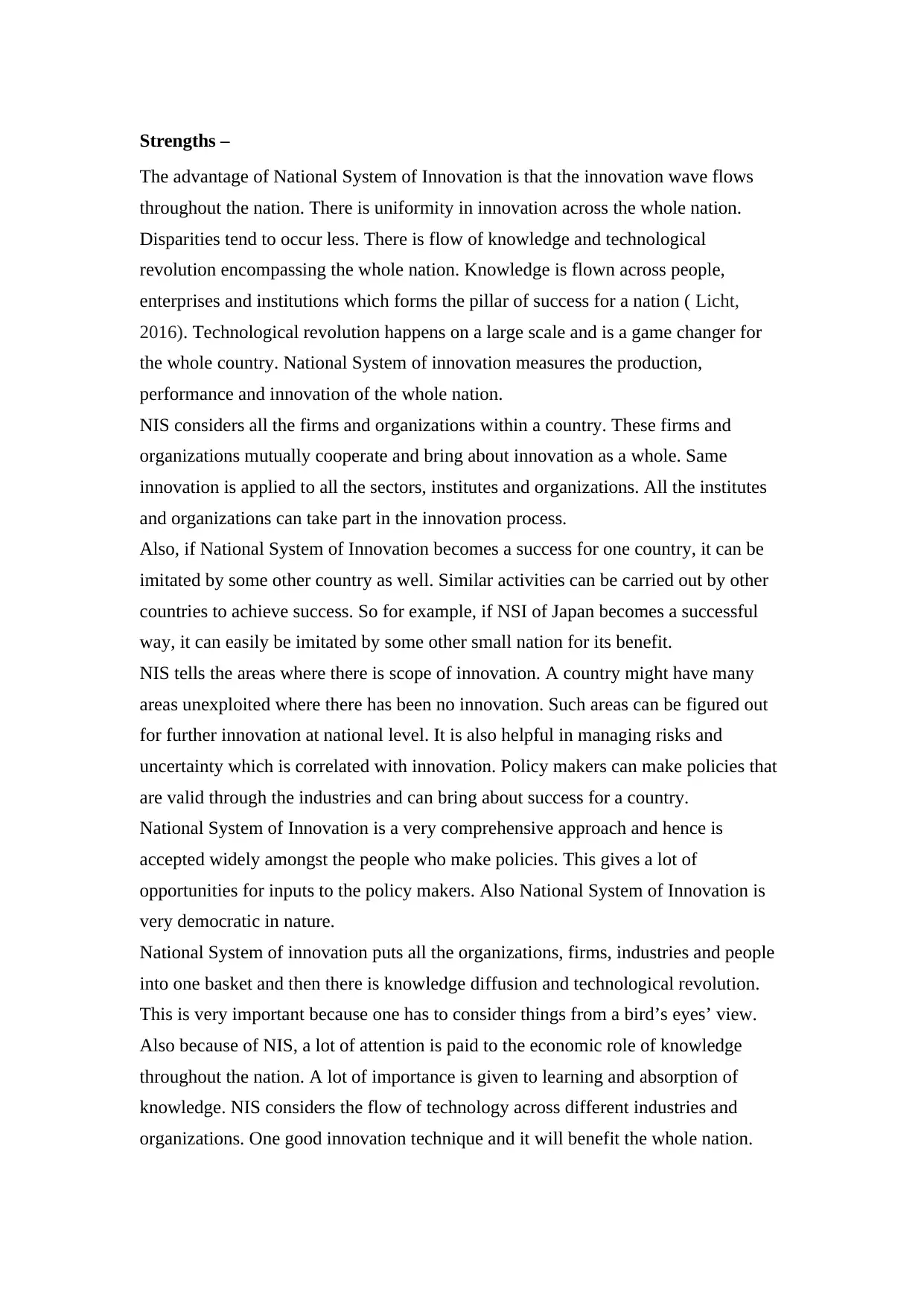
Strengths –
The advantage of National System of Innovation is that the innovation wave flows
throughout the nation. There is uniformity in innovation across the whole nation.
Disparities tend to occur less. There is flow of knowledge and technological
revolution encompassing the whole nation. Knowledge is flown across people,
enterprises and institutions which forms the pillar of success for a nation ( Licht,
2016). Technological revolution happens on a large scale and is a game changer for
the whole country. National System of innovation measures the production,
performance and innovation of the whole nation.
NIS considers all the firms and organizations within a country. These firms and
organizations mutually cooperate and bring about innovation as a whole. Same
innovation is applied to all the sectors, institutes and organizations. All the institutes
and organizations can take part in the innovation process.
Also, if National System of Innovation becomes a success for one country, it can be
imitated by some other country as well. Similar activities can be carried out by other
countries to achieve success. So for example, if NSI of Japan becomes a successful
way, it can easily be imitated by some other small nation for its benefit.
NIS tells the areas where there is scope of innovation. A country might have many
areas unexploited where there has been no innovation. Such areas can be figured out
for further innovation at national level. It is also helpful in managing risks and
uncertainty which is correlated with innovation. Policy makers can make policies that
are valid through the industries and can bring about success for a country.
National System of Innovation is a very comprehensive approach and hence is
accepted widely amongst the people who make policies. This gives a lot of
opportunities for inputs to the policy makers. Also National System of Innovation is
very democratic in nature.
National System of innovation puts all the organizations, firms, industries and people
into one basket and then there is knowledge diffusion and technological revolution.
This is very important because one has to consider things from a bird’s eyes’ view.
Also because of NIS, a lot of attention is paid to the economic role of knowledge
throughout the nation. A lot of importance is given to learning and absorption of
knowledge. NIS considers the flow of technology across different industries and
organizations. One good innovation technique and it will benefit the whole nation.
The advantage of National System of Innovation is that the innovation wave flows
throughout the nation. There is uniformity in innovation across the whole nation.
Disparities tend to occur less. There is flow of knowledge and technological
revolution encompassing the whole nation. Knowledge is flown across people,
enterprises and institutions which forms the pillar of success for a nation ( Licht,
2016). Technological revolution happens on a large scale and is a game changer for
the whole country. National System of innovation measures the production,
performance and innovation of the whole nation.
NIS considers all the firms and organizations within a country. These firms and
organizations mutually cooperate and bring about innovation as a whole. Same
innovation is applied to all the sectors, institutes and organizations. All the institutes
and organizations can take part in the innovation process.
Also, if National System of Innovation becomes a success for one country, it can be
imitated by some other country as well. Similar activities can be carried out by other
countries to achieve success. So for example, if NSI of Japan becomes a successful
way, it can easily be imitated by some other small nation for its benefit.
NIS tells the areas where there is scope of innovation. A country might have many
areas unexploited where there has been no innovation. Such areas can be figured out
for further innovation at national level. It is also helpful in managing risks and
uncertainty which is correlated with innovation. Policy makers can make policies that
are valid through the industries and can bring about success for a country.
National System of Innovation is a very comprehensive approach and hence is
accepted widely amongst the people who make policies. This gives a lot of
opportunities for inputs to the policy makers. Also National System of Innovation is
very democratic in nature.
National System of innovation puts all the organizations, firms, industries and people
into one basket and then there is knowledge diffusion and technological revolution.
This is very important because one has to consider things from a bird’s eyes’ view.
Also because of NIS, a lot of attention is paid to the economic role of knowledge
throughout the nation. A lot of importance is given to learning and absorption of
knowledge. NIS considers the flow of technology across different industries and
organizations. One good innovation technique and it will benefit the whole nation.
Paraphrase This Document
Need a fresh take? Get an instant paraphrase of this document with our AI Paraphraser
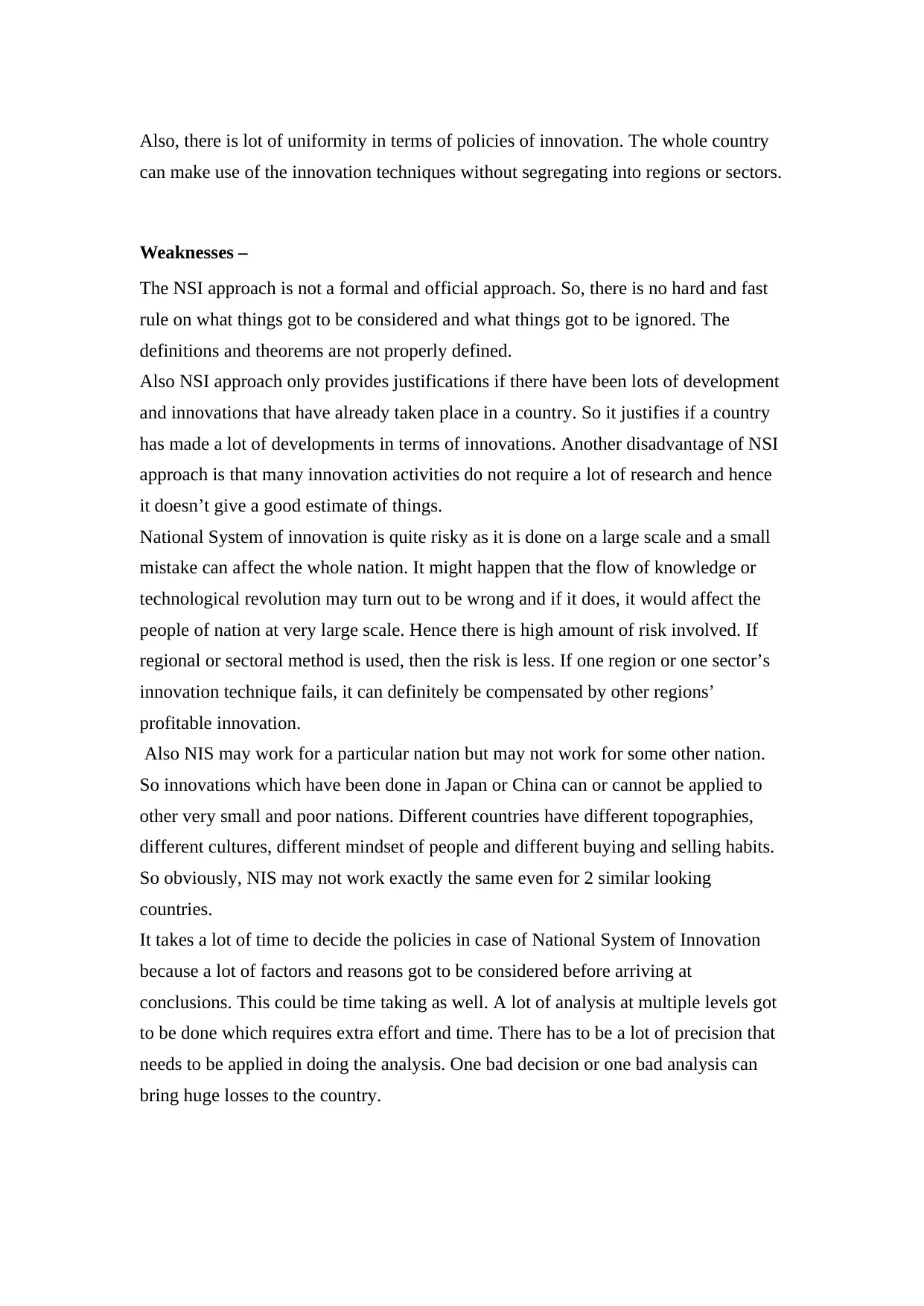
Also, there is lot of uniformity in terms of policies of innovation. The whole country
can make use of the innovation techniques without segregating into regions or sectors.
Weaknesses –
The NSI approach is not a formal and official approach. So, there is no hard and fast
rule on what things got to be considered and what things got to be ignored. The
definitions and theorems are not properly defined.
Also NSI approach only provides justifications if there have been lots of development
and innovations that have already taken place in a country. So it justifies if a country
has made a lot of developments in terms of innovations. Another disadvantage of NSI
approach is that many innovation activities do not require a lot of research and hence
it doesn’t give a good estimate of things.
National System of innovation is quite risky as it is done on a large scale and a small
mistake can affect the whole nation. It might happen that the flow of knowledge or
technological revolution may turn out to be wrong and if it does, it would affect the
people of nation at very large scale. Hence there is high amount of risk involved. If
regional or sectoral method is used, then the risk is less. If one region or one sector’s
innovation technique fails, it can definitely be compensated by other regions’
profitable innovation.
Also NIS may work for a particular nation but may not work for some other nation.
So innovations which have been done in Japan or China can or cannot be applied to
other very small and poor nations. Different countries have different topographies,
different cultures, different mindset of people and different buying and selling habits.
So obviously, NIS may not work exactly the same even for 2 similar looking
countries.
It takes a lot of time to decide the policies in case of National System of Innovation
because a lot of factors and reasons got to be considered before arriving at
conclusions. This could be time taking as well. A lot of analysis at multiple levels got
to be done which requires extra effort and time. There has to be a lot of precision that
needs to be applied in doing the analysis. One bad decision or one bad analysis can
bring huge losses to the country.
can make use of the innovation techniques without segregating into regions or sectors.
Weaknesses –
The NSI approach is not a formal and official approach. So, there is no hard and fast
rule on what things got to be considered and what things got to be ignored. The
definitions and theorems are not properly defined.
Also NSI approach only provides justifications if there have been lots of development
and innovations that have already taken place in a country. So it justifies if a country
has made a lot of developments in terms of innovations. Another disadvantage of NSI
approach is that many innovation activities do not require a lot of research and hence
it doesn’t give a good estimate of things.
National System of innovation is quite risky as it is done on a large scale and a small
mistake can affect the whole nation. It might happen that the flow of knowledge or
technological revolution may turn out to be wrong and if it does, it would affect the
people of nation at very large scale. Hence there is high amount of risk involved. If
regional or sectoral method is used, then the risk is less. If one region or one sector’s
innovation technique fails, it can definitely be compensated by other regions’
profitable innovation.
Also NIS may work for a particular nation but may not work for some other nation.
So innovations which have been done in Japan or China can or cannot be applied to
other very small and poor nations. Different countries have different topographies,
different cultures, different mindset of people and different buying and selling habits.
So obviously, NIS may not work exactly the same even for 2 similar looking
countries.
It takes a lot of time to decide the policies in case of National System of Innovation
because a lot of factors and reasons got to be considered before arriving at
conclusions. This could be time taking as well. A lot of analysis at multiple levels got
to be done which requires extra effort and time. There has to be a lot of precision that
needs to be applied in doing the analysis. One bad decision or one bad analysis can
bring huge losses to the country.
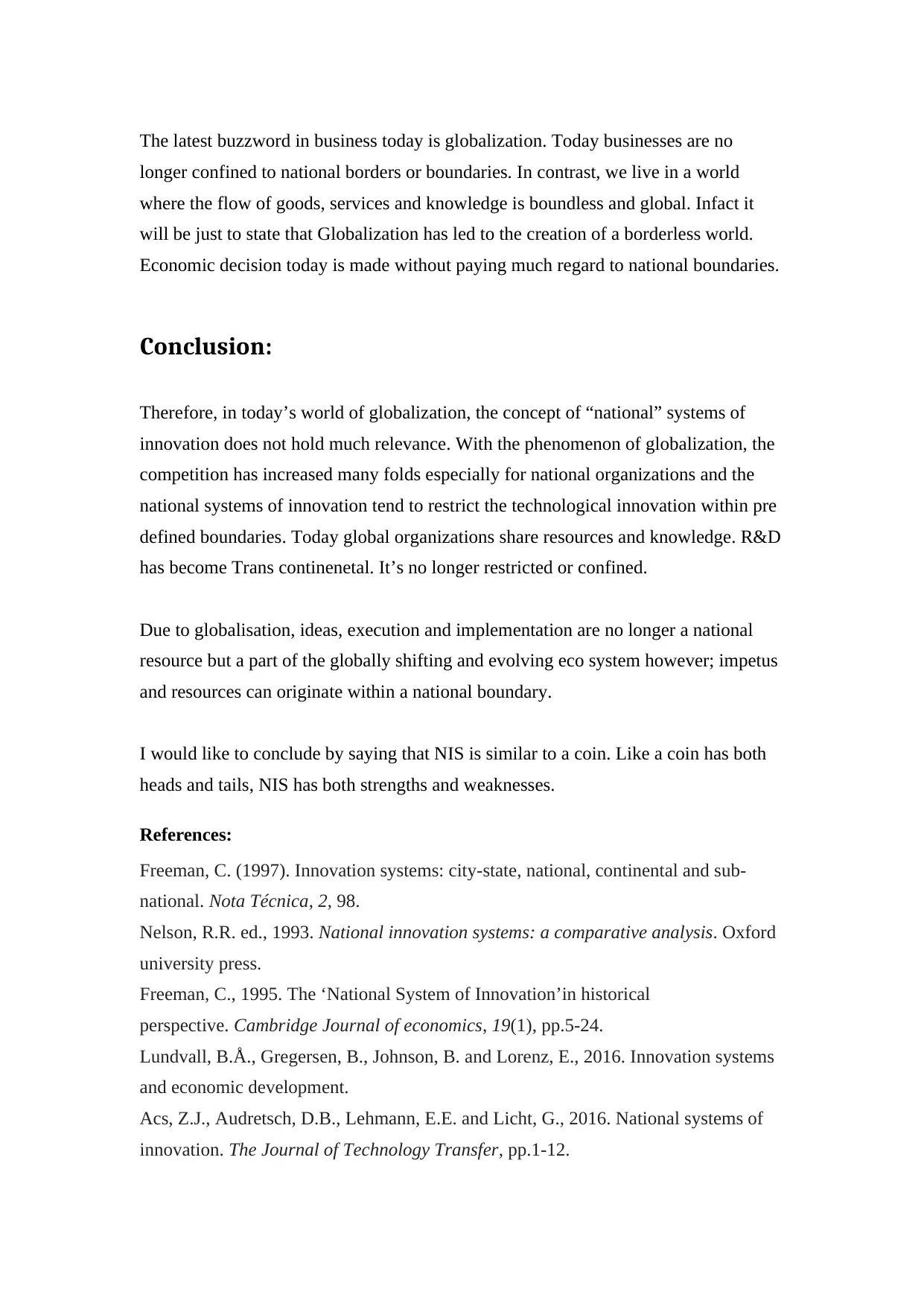
The latest buzzword in business today is globalization. Today businesses are no
longer confined to national borders or boundaries. In contrast, we live in a world
where the flow of goods, services and knowledge is boundless and global. Infact it
will be just to state that Globalization has led to the creation of a borderless world.
Economic decision today is made without paying much regard to national boundaries.
Conclusion:
Therefore, in today’s world of globalization, the concept of “national” systems of
innovation does not hold much relevance. With the phenomenon of globalization, the
competition has increased many folds especially for national organizations and the
national systems of innovation tend to restrict the technological innovation within pre
defined boundaries. Today global organizations share resources and knowledge. R&D
has become Trans continenetal. It’s no longer restricted or confined.
Due to globalisation, ideas, execution and implementation are no longer a national
resource but a part of the globally shifting and evolving eco system however; impetus
and resources can originate within a national boundary.
I would like to conclude by saying that NIS is similar to a coin. Like a coin has both
heads and tails, NIS has both strengths and weaknesses.
References:
Freeman, C. (1997). Innovation systems: city-state, national, continental and sub-
national. Nota Técnica, 2, 98.
Nelson, R.R. ed., 1993. National innovation systems: a comparative analysis. Oxford
university press.
Freeman, C., 1995. The ‘National System of Innovation’in historical
perspective. Cambridge Journal of economics, 19(1), pp.5-24.
Lundvall, B.Å., Gregersen, B., Johnson, B. and Lorenz, E., 2016. Innovation systems
and economic development.
Acs, Z.J., Audretsch, D.B., Lehmann, E.E. and Licht, G., 2016. National systems of
innovation. The Journal of Technology Transfer, pp.1-12.
longer confined to national borders or boundaries. In contrast, we live in a world
where the flow of goods, services and knowledge is boundless and global. Infact it
will be just to state that Globalization has led to the creation of a borderless world.
Economic decision today is made without paying much regard to national boundaries.
Conclusion:
Therefore, in today’s world of globalization, the concept of “national” systems of
innovation does not hold much relevance. With the phenomenon of globalization, the
competition has increased many folds especially for national organizations and the
national systems of innovation tend to restrict the technological innovation within pre
defined boundaries. Today global organizations share resources and knowledge. R&D
has become Trans continenetal. It’s no longer restricted or confined.
Due to globalisation, ideas, execution and implementation are no longer a national
resource but a part of the globally shifting and evolving eco system however; impetus
and resources can originate within a national boundary.
I would like to conclude by saying that NIS is similar to a coin. Like a coin has both
heads and tails, NIS has both strengths and weaknesses.
References:
Freeman, C. (1997). Innovation systems: city-state, national, continental and sub-
national. Nota Técnica, 2, 98.
Nelson, R.R. ed., 1993. National innovation systems: a comparative analysis. Oxford
university press.
Freeman, C., 1995. The ‘National System of Innovation’in historical
perspective. Cambridge Journal of economics, 19(1), pp.5-24.
Lundvall, B.Å., Gregersen, B., Johnson, B. and Lorenz, E., 2016. Innovation systems
and economic development.
Acs, Z.J., Audretsch, D.B., Lehmann, E.E. and Licht, G., 2016. National systems of
innovation. The Journal of Technology Transfer, pp.1-12.
⊘ This is a preview!⊘
Do you want full access?
Subscribe today to unlock all pages.

Trusted by 1+ million students worldwide
1 out of 13
Related Documents
Your All-in-One AI-Powered Toolkit for Academic Success.
+13062052269
info@desklib.com
Available 24*7 on WhatsApp / Email
![[object Object]](/_next/static/media/star-bottom.7253800d.svg)
Unlock your academic potential
Copyright © 2020–2025 A2Z Services. All Rights Reserved. Developed and managed by ZUCOL.





